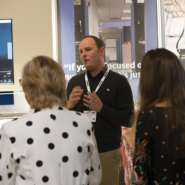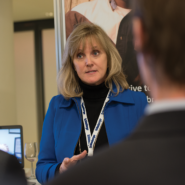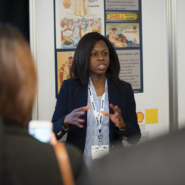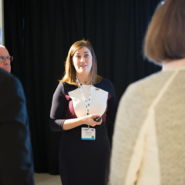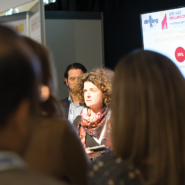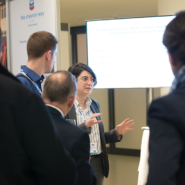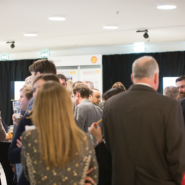Women have traditionally been underrepresented in the oil and gas industry, but many companies and individuals are now working to change that. Increasing the number of women in the industry’s workforce starts with attracting and hiring women into the industry. However, the industry often does a poor job of selling itself and its benefits to women, said Katie Mehnert, Founder and CEO of Pink Petro, an organization that aims to increase gender diversity in the oil and gas industry. Ms Mehnert participated in a panel session on gender diversity at the 2017 SPE/IADC Drilling Conference in The Hague, The Netherlands, on 15 March. In this video from the conference, she explains some of the barriers women still face in the oil and gas industry, as well as practical steps that companies can take to address the gender gap within their organizations.
By Kelli Ainsworth, Associate Editor

The oil and gas industry is still very much dominated by men. The vast majority of this industry’s jobs, especially those in senior management and engineering, are held by men. At the 2016 World Economic Forum in Davos, Switzerland, executives from 22 oil and gas companies made a commitment to close this gender gap. These companies published a document, “Closing the Gender Gap in Oil and Gas: A Call to Action,” as a step toward increasing gender diversity in the industry. “It’s not acceptable to have less than 15% of our workforce as women in the energy industry,” said Oonagh Werngren, Chair of The Girl’s Network, who moderated a special session on addressing the gender gap at the 2017 SPE/IADC Drilling Conference in The Hague, The Netherlands, on 15 March.

Even in countries like Norway, which is often held up as a beacon of gender equality, there are still struggles with gender diversity in the workplace, said Hege Kverneland, Corporate VP and Chief Technology Officer at National Oilwell Varco (NOV). On the surface, the country appears to have broken down most gender barriers. It elected its first female prime minister in the 1980s, can boast that 40% of the members of its public boards are women, and has generous maternity leave policies that benefit women and families.
But all is not as it appears, Ms Kverneland said. “We claim we’re good, but actually we’re not.” As recently as 2003, women held only 7% of the seats on public boards in Norway; change didn’t occur until the government mandated 40% female representation. And while the country’s maternity leave policy is generous, it also has a downside of keeping women out of the workforce for significant periods of time, particularly if they have more than one child. “We have a fantastic system, but it’s not necessarily making sure that women get in better positions,” she said.
From an employment standpoint, women in Norway aren’t necessarily faring any better than their counterparts in the US or other countries. Ms Kverneland cited a study showing that American women actually hold more leadership positions in the tech industry than Norwegian women do. Further, she shared data from NOV Norway showing that only 20% of the organization’s workforce is female.
The areas in which women are employed are also telling, she added. Women make up 60% of administrative roles, over 80% of human resources roles and 54% of HSE roles. However, only 13% of NOV Norway’s engineers are women, she said. This number is comparable with NOV’s female engineering workforce in the US, Canada and the rest of Europe. “Again, Norway or Europe is not particularly better than anywhere else,” she said.

Such underrepresentation of women, which can be found across the oil and gas industry, is what prompted Katie Mehnert, to found and lead Pink Petro, a global online community that connects and develops women oil and gas professionals. Ms Mehnert had come up with the idea for PinkPetro while she was an HSE professional in the oil and gas industry. During a transatlantic flight, the man seated next to her questioned why she, as a woman, was working in oil and gas. “Over 50% of the workforce are women… Why don’t we see more of them in the industry?” she wondered.
In 2015, she formally launched PinkPetro with the goal of attracting and developing diverse talent to the industry. “We really aim to tell the energy stories from the front line and elevate talent,” Ms Mehnert said. “No one’s going to join this business unless they understand the meaning of what we do. We just don’t do a good job at that.” Since its launch, the PinkPetro community has grown to 8,000 members across 120 countries.
In mid-2016, PinkPetro gathered input from its members and drafted a response to the industry’s call to action to close the gender gap, outlining steps that could be taken to recruit and promote more women. “We can talk about this all we want, but we need to move to action,” Ms Mehnert said. Closing the gender gap isn’t just beneficial for women but also for the industry, as well. “If we have inclusive companies, we’re going to have safe and reliable companies. We’re going to have profitable and better companies.”

For Olav Skår, Global Wells Learning Manager at Shell, there is a firm belief that having a diverse workforce makes a company stronger. He cited a study by McKinsey and Company, which found that ethnically diverse companies are 35% more likely to succeed and stand out from their competition, while companies that are gender diverse are 15% more likely to do so. Shell’s own internal study also shows that employee engagement correlates with diversity and inclusiveness. “It turns out that a 10-point increase in that measure on a team level results in 30-40% less incidents,” Mr Skår said.
While metrics are important, diversity and inclusion must go beyond raw numbers. In fact, Mr Skår said he believes that tying gender and inclusion to a specific metric, such as 50% of the workforce, or hiring a female CEO, is not a productive way to address the gender gap. “I believe having those (numbers) as your point takes us down a path that doesn’t enable us to take the next steps and improve as an industry,” he said.
Shell has set internal diversity goals that “are aligned toward a bigger aim than just a number,” he said, adding that individuals within companies must set their own goals for diversity. Personally, Mr Skår said, he has committed to proactively identify female employees to work on his team. “We’ve taken significant strides over many years. I’m confident in our industry and us as individuals that we have the results, we know where to go, and we can make a difference.”

